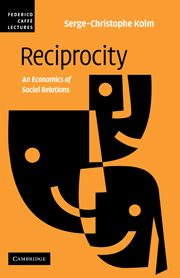4 - Forms and structures of reciprocity
Published online by Cambridge University Press: 22 September 2009
Summary
Facts and relations
Reciprocity takes a variety of forms which are more or less close to or distant from the core meaning of the concept. It consists of relations between facts such as actions, sentiments, attitudes or judgments, each belonging to one person and concerning another or others, that are directly related by motivations. In standard cases, these facts concern two agents, they are from one to the other and vice versa. In extensions of the concept, however, only one person is concerned in the two facts, or both original agents are replaced by two different ones (as explained shortly). The agents are often individuals, but they can also be groups or institutions of various kinds. The various cases depend on the nature of these facts and people, on the structure of the relationship and the number of people and of facts involved, and – most essentially – on the types of motives that induce the relation.
These facts can be of various natures. They can be actions favourable to the other person, as with the basic gift/return-gift relation, or unfavourable to the other, as with revenge (and retaliation for deterrence). There are also reciprocities of sentiments, as with liking people who like you (explained in chapter 7). There are reciprocities of attitudes, which are induced by sentiments or reasons and may denote propensity to action.
- Type
- Chapter
- Information
- ReciprocityAn Economics of Social Relations, pp. 74 - 94Publisher: Cambridge University PressPrint publication year: 2008



